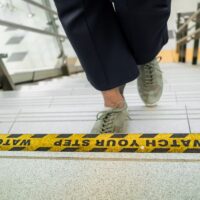How to Prove Liability in a New York Stairway Accident Case

Stairway accidents are a common cause of injuries in New York, often resulting in severe harm such as fractures, head injuries, back and neck injuries, and even spinal damage. If you’ve been hurt in a stairway accident due to someone else’s negligence, you might be entitled to compensation, but proving liability in these cases is crucial for a successful claim. Below we explore how to establish liability in a New York stairway accident case. For help with a slip and fall or trip and fall claim in NYC, contact Leandros A. Vrionedes, P.C., to speak with an experienced and dedicated New York stairway accident lawyer.
Understanding Stairway Accident Liability
To hold someone liable for your stairway accident injuries, you must demonstrate that their negligence directly caused the accident. In New York, premises liability law dictates that property owners have a duty to maintain their premises in a reasonably safe condition. Failure to do so can make them liable for accidents occurring on their property.
As with any personal injury or negligence case, proving liability in a stairway accident requires proving several elements, including duty of care, breach of duty, causation and damages. We’ll discuss these elements below in relation to stairway accidents specifically.
1. Duty of Care
First, you need to establish that the property owner or occupier owed you a duty of care. This duty means that the property owner must ensure the stairways are safe for use. This duty extends to various parties, including landlords, business owners, and even tenants, depending on the circumstances.
2. Breach of Duty
Next, you must prove that the property owner breached their duty of care. In a stairway accident, this generally means the responsible party either created a dangerous condition, or they knew about the hazard or should have known about yet failed to remedy the danger in a reasonable time, such as by fixing the defect, securing the area, or putting up an adequate warning. Breach of duty can occur in several ways, such as:
- Poor Maintenance: Failing to repair broken or uneven steps.
- Inadequate Lighting: Insufficient lighting leading to poor visibility.
- Lack of Handrails: Absence of necessary handrails or failure to repair loose handrails.
- Slippery Surfaces: Not addressing slippery conditions caused by water, ice, spills, or debris.
3. Causation
You must show a direct link between the breach of duty and your accident. This means demonstrating that the property owner’s negligence was the primary cause of your fall and subsequent injuries. For instance, if you slipped due to a broken step that the property owner knew about but did not fix, you need to prove this direct connection.
4. Damages
Finally, you must prove that you suffered actual damages due to the accident. Damages can include medical bills, lost wages, pain and suffering, and other related expenses. Thorough documentation, such as medical records and financial statements, will support your claim for compensation.
Gathering Evidence for Your Case
Collecting and preserving evidence is crucial to proving liability in a stairway accident case. Some key areas to focus on include photographic evidence, witness statements, incident reports, medical records and maintenance records. If you can, take clear photographs of the accident scene, focusing on the hazardous condition that caused your fall. Capture images of broken steps, poor lighting, or any other contributing factors. Additionally, witnesses can provide valuable testimony to support your claim. Obtain contact information from anyone who saw the accident or was aware of the hazardous condition.
If your accident occurred in a commercial building, report the incident to the management and request a copy of the incident report. This document can serve as evidence of the accident and the condition of the stairway at the time. If possible, obtain records of the property’s maintenance history. These records can demonstrate whether the property owner was aware of the hazardous condition and failed to address it.
Medical records are another critical piece of evidence. It’s important to seek immediate medical attention following the accident, which might include calling 911 and being treated at the scene if necessary. Otherwise, follow up with a physician as soon as possible for a thorough examination. Detailed medical records documenting your injuries and treatment are essential for proving the extent of your damages.
Legal Assistance from a Personal Injury Attorney
Proving liability in a stairway accident case can be complex and challenging. It often involves intricate legal principles and detailed evidence gathering. Working with an experienced New York personal injury attorney can significantly improve your chances of a successful claim.
An attorney can help you:
- Investigate the accident thoroughly.
- Gather and preserve critical evidence, including obtaining company records and surveillance footage.
- Identify liable parties, which might include property owners, landlords, sublet tenants, and third parties such as maintenance crews, repair persons, custodial staff, etc.
- Negotiate with insurance companies.
- Represent you in court if necessary.
Contact Leandros A. Vrionedes, P.C. for Help After a Stairway Accident in NYC
Stairway accidents can lead to severe injuries and significant financial burdens. Proving liability in such cases requires a clear understanding of premises liability law and diligent evidence gathering. By following the steps outlined above and seeking professional legal assistance, you can effectively build your case and pursue the compensation you deserve. If you or a loved one has been injured in a stairway accident in New York, call Leandros A. Vrionedes, P.C. at 212-889-9362 for a free consultation, legal guidance and support.


